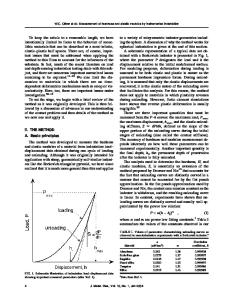Ultralow-load indentation hardness and modulus of diamond films deposited by hot-filament-assisted CVD
- PDF / 1,613,484 Bytes
- 7 Pages / 593.28 x 841.68 pts Page_size
- 102 Downloads / 343 Views
C.V. Cooper United Technologies Research Center, East Hartford, Connecticut 06108
T. A. Perry General Motors Research Laboratories, Warren, Michigan 48090 (Received 25 April 1990; accepted 18 July 1990)
Diamond films, ranging in thickness to approximately 35 /u.m, were grown on Si(100) substrates using hot-filament-assisted CVD. Two different CH 4 :H 2 ratios were employed during deposition, and the effects on the film morphology and ultralow-load indentation hardness and modulus were investigated. Films deposited from a single, linear filament exhibited a nonuniform deposition thickness profile that can be described by a simple exponential function. Films deposited at lower methane concentrations, 0.11% CH4 in H2, had larger crystallite sizes of —5-8 ^.m, an average hardness of 31 GPa, and an average modulus of 541 GPa. A higher CH4 concentration of 0.99% in H 2 resulted in the formation of finer crystallites of approximately 0.5 fim, an average hardness of 65 GPa, and an average modulus of 875 GPa. While these values lie on the low end or outside of the range reported for single crystal diamond, this study has demonstrated that CVD diamond films can be synthesized with ultrahigh or near ultrahigh hardness.
I. INTRODUCTION
Diamond has a very wide band gap (5.45 eV) and hence is optically transparent over an extremely broad portion of the electromagnetic spectrum and is ideally suited as a hard, transparent, protective coating material for infrared optical elements. Until recently, the full potential of diamond as an optical coating material had not been realized. Diamond has been available only in the form of relatively small sized crystals from natural or man-made sources (high temperature, high pressure techniques) and is employed primarily as a window material.1 This situation is changing quickly due to significant advances in diamond science over the past several years in the area of thin film deposition2"6; hence, the number of possible optical applications of diamond is expanding rapidly. Diamond is particularly useful as a protective optical coating in applications where the optical element may be subjected to chemically aggressive or abrasive environments and/or extreme thermal shock. Protective coatings subjected to thermal shock conditions can be characterized by their thermal shock resistance parameter, R, given by7 R = (1 -
films grown under two different sets of conditions. Although the parameters in this expression are well established for bulk diamonds, very little is known about these parameters for thin diamond films. As has been shown previously,8 the thermal conductivity of diamond films at room temperature ranges from approximately 1000 W/m K to 100 W/m K, depending on the carbon/hydrogen ratio used during film growth. The thermal conductivity of diamond films may be a factor of 2 to 20 times less than that of Type Ha diamond, depending on the film growth parameters; therefore, it is not unreasonable to expect differences in other parameters between thin film and bulk values. This paper pr
Data Loading...










